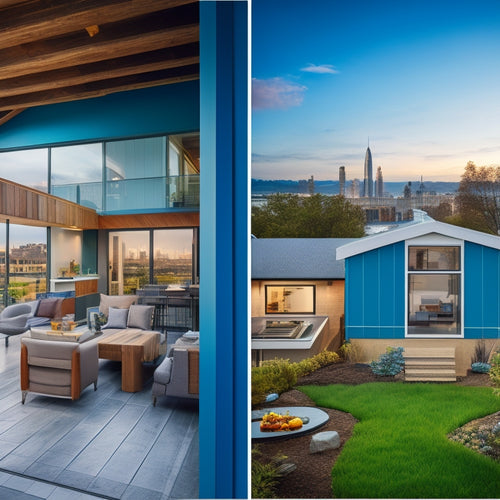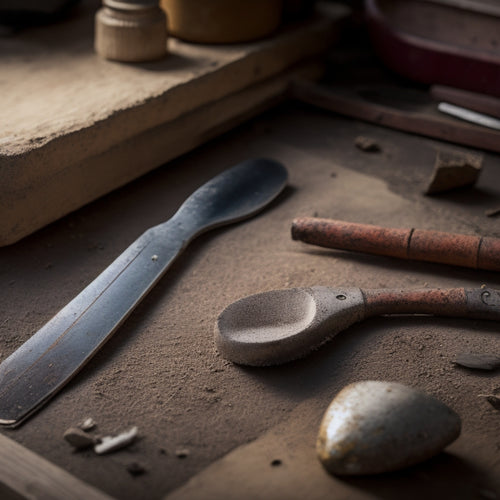
Renovation Budgeting Checklist Template Download
Share
As you prepare to download a renovation budgeting checklist template, remember to cover essential items like financing options, cost-effective materials, permits, labor costs, and contingency funds. Prioritize your needs and wants, allocating funds accordingly, and be prepared to compromise on 'nice-to-haves.' Don't forget to factor in hidden costs like permit issues, structural damage, and outdated systems. Track every dollar spent and schedule progress monitoring sessions to avoid budget overruns. By following these steps, you'll be well on your way to creating a thorough budget that sets your renovation up for success - and reveals even more vital details to help you stay on track.
Key Takeaways
• Evaluate financing options and budget for permits, labor costs, and contingency funds to avoid budget overruns.
• Identify non-negotiable aspects of the renovation and categorize priorities into needs and wants to make informed decisions.
• Consider allocating 10-20% of the budget for contingencies, including electrical, plumbing, structural, and permit issues.
• Monitor every dollar spent and track progress using a centralized hub, charts, or project management tools to make adjustments.
• Prepare for potential financial stress from unforeseen expenses by having a clear plan and budget in place.
Essential Renovation Budget Items
Five essential renovation budget items demand your attention from the get-go, as they'll greatly impact your project's overall cost and success.
You're probably thinking, 'What are these magical items?' Well, let's plunge into it!
First up, you need to evaluate renovation financing options. Will you be tapping into your savings, taking out a loan, or using a credit card? Knowing your financing options will help you determine how much you can realistically spend.
Next, you'll want to reflect on cost-effective materials. You don't have to break the bank to get the look you want. Consider using reclaimed wood, engineered quartz, or porcelain tiles instead of their pricier counterparts.
Other essential items to budget for include permits, labor costs, and contingency funds (because let's face it, unexpected expenses always pop up).
Finally, don't forget to factor in the cost of any necessary inspections and testing, like asbestos or lead paint testing.
Allocating Funds to Priorities
With your essential budget items in place, you'll need to allocate your funds to priorities, deciding which aspects of your renovation dream take center stage and which can take a backseat.
This is where the fun begins – and by fun, I mean the part where you get to make some tough decisions. Think of it like planning a party: you can't invite everyone, so you prioritize the guest list. In this case, your guests are the must-haves, nice-to-haves, and 'if-we-have-extra-cash' haves.
To allocate your funds effectively, start by evaluating your priorities. What's non-negotiable? What can you live without? Be honest with yourself – if you're not willing to sacrifice that fancy kitchen island, then it's a priority.
Next, categorize your priorities into needs and wants. This will help you visualize where your funds should go. Remember, funds allocation is an art, not a science. You'll need to make some compromises, but with a clear priority evaluation, you'll be able to allocate your funds wisely and make your renovation dreams a reality.
Hidden Costs to Consider
As you're busy allocating funds to your renovation priorities, it's easy to overlook the sneaky expenses that can blow your budget, but it's time to shine a light on those hidden costs that can make or break your project.
Think of them as the renovation equivalent of that one cousin at the family reunion – unexpected and potentially costly.
Renovation permits, for instance, can be a major unexpected expense. You might think you're all set with your plans, but the city has other ideas, and suddenly you're shelling out an extra $1,000 for a permit you never knew you needed.
And don't even get me started on the costs of repairing hidden structural damage or replacing outdated electrical systems. It's like finding out your dream home has a secret addiction to expensive repairs.
To avoid getting caught off guard, make sure to factor in these potential hidden costs into your budget.
You mightn't be able to anticipate every surprise, but being prepared for the unexpected will save you from a world of financial stress.
Budgeting for Contingencies
Budgeting for Contingencies
Your contingency fund is like a safety net, stretched taut and ready to catch any unexpected expenses that come tumbling down during the renovation process. Think of it as your emergency fund, saving you from financial shock when the unexpected happens. And, let's face it, unexpected expenses are a renovation's best friend – they always seem to pop up when you least expect them.
Here's a rough guide to help you plan for contingencies:
| Contingency Type | Likelihood | Cost Range |
| Electrical issues | High | $500 - $2,000 |
| Plumbing problems | Medium | $300 - $1,500 |
| Structural damage | Low | $1,000 - $5,000 |
| Permit issues | Medium | $200 - $1,000 |
| Design changes | High | $500 - $3,000 |
Tracking Expenses and Progress
You're constantly monitoring the renovation's pulse, tracking every dollar spent and task completed to guarantee your dream project stays on course. This laser-like focus on expense tracking and progress monitoring is essential to avoiding budget blowouts and timeline delays.
Think of it as keeping a hawk's eye on your renovation's critical signs – pulse, blood pressure, and oxygen levels (aka, your sanity).
Create a centralized hub, like a spreadsheet or project management tool, to log every expense, no matter how small. This will help you identify areas where costs are creeping up and make adjustments accordingly.
Regularly schedule progress monitoring sessions with your contractor or team to review completed tasks, discuss upcoming milestones, and tweak the plan as needed.
Visualize your project's progress with charts, graphs, or a Kanban board – whatever works for you! By keeping a close eye on expenses and progress, you'll be able to make informed decisions, stay within budget, and bring your dream renovation to life.
Frequently Asked Questions
Can I Renovate a Single Room Without Disrupting the Entire House?
You're wondering if you can renovate a single room without turning your entire house into a chaotic mess? Absolutely!
With some clever room isolation techniques, you can contain the chaos and get the job done without disrupting your daily routine.
Plus, with budget-friendly renovations, you can achieve a stunning makeover without breaking the bank.
Think zippered plastic walls, drop cloths, and strategic furniture rearrangement – and voilà! Your solo room renovation will be a breeze.
How Do I Handle Changes to the Renovation Plan Mid-Project?
When mid-project changes strike, don't panic!
You're not alone - it's common to deviate from the original plan. Be flexible, and remember, it's okay to pivot.
You'll need to make budget adjustments, but don't sacrifice your vision. Assess the impact, prioritize, and adjust accordingly.
Think of it as a fun puzzle to solve. With a clear head and a willingness to adapt, you'll navigate these changes like a pro and still achieve your dream renovation!
Should I Involve My Neighbors in the Renovation Planning Process?
You're wondering if you should clue in your neighbors about the renovation chaos that's about to ensue.
Here's the thing: being upfront with them can be a game-changer. Good neighborhood communication is key to avoiding those awkward 'what's going on with your house?' encounters.
It's all about renovation etiquette, folks! By keeping them in the loop, you'll avoid potential disputes and earn some serious brownie points.
What if I Want to Reuse or Repurpose Existing Materials?
So, you're thinking of getting creative with existing materials, huh? That's awesome!
Reusing or repurposing them can be a fantastic way to save some serious cash. You'll be a master of material sourcing, and your wallet will thank you.
Plus, it's a great opportunity to get crafty and add some unique touches to your space.
Just remember to inspect those materials carefully before giving them new life – you don't want any surprises down the line!
Do I Need to Hire a Professional Project Manager for My Renovation?
You're probably juggling a million renovation tasks, and it's easy to get overwhelmed.
That's where a project manager comes in - they'll help you stay on track, guarantee budget management is on point, and keep those pesky delays at bay.
Think of them as your renovation superhero, saving the day (and your sanity) one to-do list at a time!
Conclusion
As you commence your renovation journey, remember that a well-crafted budget is your shield against financial shocks.
Don't let unwelcome surprises rain on your parade; instead, allocate funds wisely, prioritize must-haves, and pad your budget for those pesky hidden costs.
By tracking expenses and progress, you'll be the master of your renovation domain.
With a clear financial roadmap, you'll transform your space without breaking the bank – or your spirit.
Related Posts
-

Budget-Friendly Materials for Your Home Renovation Project
As you plan your home renovation project, finding budget-friendly materials is key to turning your design vision into...
-

Top 3 Insurance Options for Home Renovation
When renovating your home, you need specialized insurance coverage to protect your finances from unexpected setbacks ...
-

Why Inspect Stucco Repair Equipment Before Renovation
When starting a stucco repair renovation, you need to inspect your equipment to prevent accidents, save time and mone...


